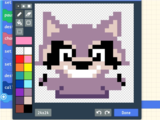In Trash Panda 2: Garbage Day, you play as the suburban dweller just trying to get some sleep when the raccoons and cats decide its time to make noise and throw garbage our of the trash bins! You must try to stop them by shining your flashlight on them. But you can only play at night, so be sure that your PyGamer or PyBadge's light sensor indicates it's dark out!
With this game, you'll learn about tile arrays, gravity, using the light sensor, and more! Plus, you can have fun challenging your friends to see who can get the highest score!
Parts
You can play Trash Panda 2 in the browser by turning on "debug" mode, but for the full experience and to use the light sensor, you can play it on a PyGamer or PyBadge.

































































